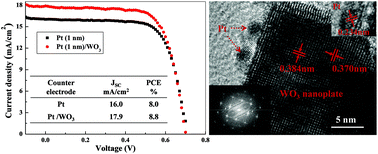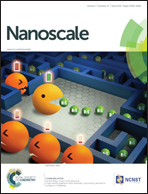Tungsten trioxide nanoplate array supported platinum as a highly efficient counter electrode for dye-sensitized solar cells†
Abstract
A tungsten trioxide (WO3) nanoplate array is fabricated directly on the FTO/glass substrate and used as a platinum (Pt) nanoscale supporter for a highly efficient and low Pt-consumption counter electrode (CE) in dye-sensitized solar cells (DSCs). A Pt/WO3 composite structure, with Pt nanoparticles having a diameter of 2–3 nm, increases the electrochemical catalytic activity in catalyzing the reduction of triiodide. Accordingly, the power conversion efficiency is increased from less than 1% for WO3 CE and 8.1% for Pt CE, respectively, to 8.9% for Pt/WO3 CE. Moreover, the use of Pt/WO3 CE can dramatically reduce the consumption of scarce Pt material, with a relatively low Pt-loading of ∼2 μg cm−2, while maintaining a much better performance. The excellent performance of Pt/WO3 CE is attributed to the efficient electron injection and transport via WO3 supporters, as well as the nanostructure array morphology of WO3 for deposition of fine Pt nanoparticles. This work provides an approach for developing highly catalytic and low-cost Pt based CEs, which also has implications for the development of Pt/WO3 nanoplate arrays for other applications.


 Please wait while we load your content...
Please wait while we load your content...